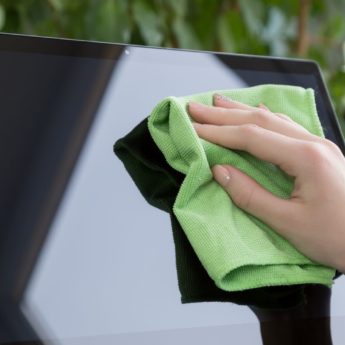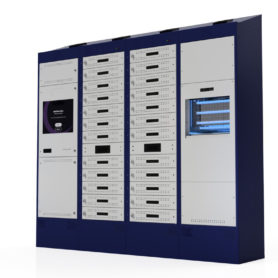How effective is sanitising your laptop manually?
And how long will it take your staff?
Shared computers, laptops, tablets and other devices play a key role throughout society in enabling access to technology.
Library computers are a vital source of online access for many users, with the vast majority of libraries providing access to the internet (99.5% according to an ALA survey of US libraries). While in an education setting, 79% of students require a computer (or tablet or laptop) for at least half their schoolwork provided by schools. When students reach secondary school (94%) and beyond, the digital requirements of studying reaches almost ubiquitous levels – 95% of higher education learning requires access to an internet-enabled device. This is one of the reasons that shared devices and laptop loans are commonplace in higher education.
But there is a problem (thanks to COVID-19).
Laptops, tablets and similar devices are a recognised haven for germs and bacteria at the best of times. Devices can be nothing short of a health hazard during the coronavirus pandemic, especially if they are handled by multiple users. However, this does nothing to reduce the reliance on shared devices felt by many.
In places of work or study where laptop loans, agile working or hot-desking are an important feature, it is imperative that you have a resilient and tested process for cleaning devices between users in place, one that is easy to execute to ensure compliance.
The High Cost of Manual Cleaning
A quick wipe over with a cloth may cut through dust, but it is unlikely to remove dangerous bacteria or viruses like COVID-19. Whilst manually cleaning devices between uses is an option, it can be tricky to find cleaning products that are strong enough to kill germs yet gentle enough not to cause abrasive damage or worse to the laptop. Using disposable wipes (particularly alcohol wipes) is a traditional method for cleaning laptops but these are costly, environmentally unfriendly and have even been reported to cause significant damage to hardware.
Plus, looking beyond the tools and supplies required, the process for cleaning laptops is time-consuming and labour intensive. When it is the responsibility of a member of staff it quickly becomes very expensive! Never mind being a questionable use of resources. When the responsibility falls to the user, the question becomes “Is every device being cleaned effectively between uses?” Can you be confident? Which, of course, raises the thorny issue of compliance.

What if there was another way?
There is! UV-C light is a long-established and scientifically proven cleaning and sanitising technology. With just 6 seconds of exposure, UV-C light has been proven to remove, or inactivate, 99% of SARS-CoV-2 virus from its targeted surface*.
D-Tech’s semi-automated UV-C sanitising unit, computeIT UV-C, uses high-intensity UV-C light technology to remove 99.9% of bacteria, sanitising any device within 30 seconds. With Phillips UV-C bulbs fitted as standard, you can have total confidence in the performance of computeIT UV-C to deliver a fast and effective sanitising solution.

Confidently clean in 30 seconds? How does it work?
The unit senses when a device is placed in it or taken out and sanitises all sides of it simultaneously. Its no-touch operation ensures the user’s safety during the sanitising process, while we recommend providing hand sanitiser for users whilst their device is being sanitised – to prevent your user from contaminating the newly-clean device!
Learn more about computeIT UV-C






